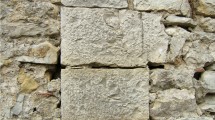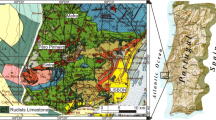Abstract
The oldest examples of architectural use of Polish black limestone date back to the late 16th century. The rock was commonly applied starting from the beginning of the 17th century, both as a structural and decorative stone used above all in tombstones and epitaph tablets, but also in fragments of altars, inner and outer portals, railings, floor slabs, baptisteries, even whole chapel interiors, etc. The rock became so popular because it is very suitable for being polished, resulting in glassy, mirror- like surfaces. The black, solemn colour was thus a perfect choice in the Counter Reformation period. The sculptors working in Dębnik, where the quarries were situated, and in Cracow, the then capital of Poland located nearby, produced countless works of small-scale architecture that spread all over the Commonwealth of Two Nations, as Poland was called. In terms of its territorial range, Poland was then the largest country in Europe, reaching the Dnieper and the Dvina to the east; and it consisted of two united parts, i.e., the Crown lands of proper Poland and the Grand Duchy of Lithuania. As a result, examples of the use of the Dębnik limestone are so numerous that in the Polish history of art the 17th and 18th centuries have been given the name “the period of the black marble”. It should be added that artifacts made of the Dębnik limestone were widely exported to the neighbouring countries. Today they can be found, e.g., in Germany (Frankfurt am Main) and Austria (Vienna, Graz, Salzburg) (Rajchel 2004 ; Niemcewicz 2005 ).
Access this chapter
Tax calculation will be finalised at checkout
Purchases are for personal use only
Preview
Unable to display preview. Download preview PDF.
Similar content being viewed by others
References
Baliński A (1989) Biostratygrafia górnego dewonu antykliny Dębnika. (Upper Devonian biostratigraphy of the Dębnik anticline). In: Rutkowski J (ed) Przewodnik LX Zjazdu PTG (LX Meeting of Polish Geological Society). Kraków, pp 30–34
Bednarczyk J, Hoffmann M (1989) Wapienie dębnickie (Dębnik limestone). In: Rutkowski J (ed) Przewodnik LX Zjazdu PTG (LX Meeting of Polish Geological Society). Kraków, pp 40–46
Benavente D, Bernabéu A, Fort R, Martínez-Martínez J, García del Cura MA (2006) The decolouration of breciated black marbles used in heritage monuments of Alicante. In: Fort R, Alvarez de Buergo M, Gomez-Heras M, Vazquez-Calvo C (eds) Heritage, weathering, and conservation, vol 1. Taylor Francis, London, pp 205–210
Bromowicz J (2001) Ocena możliwości wykorzystania skał z okolic Krakowa do rekonstrukcji kamiennych elementów architektonicznych (Application of the building stones of the Cracow area for the masonry reconstructions—evaluation of preferences). Gospodarka Surowcami Mineralnymi 17/1:16–73
Gradziński R (1972) Przewodnik geologiczny po okolicach Krakowa (Geological Guide of Cracow region). Wydawnictwo Geologiczne, Warszawa
Hermosin B, Gavino M, Saiz-Jimenez C (2004) Organic compounds in black crusts from different European monuments: a comparative study. In: Saiz-Jimenez C (ed) Air pollution and cultural heritage. Balkema, London, pp 47–55
Kozłowski R, Magiera J (1989) Niszczenie wapieni dębnickich i pińczowskich w zabytkach Krakowa (Deterioration of the Dębnik and Pinczów limestones in Cracow monuments). In: Rutkowski J (ed) Przewodnik LX Zjazdu PTG (LX Meeting of Polish Geological Society). Kraków, pp 204–208
Lewandowska A (1998) Mineralogia skarnów magnezowych grzbietu Dębnika (Mineralogy of Mg-scarns of the Dębnik hill). PhD thesis, Jagiellonian University. Kraków
Marinoni N, Pavese A, Bugini R, Di Silvestro G (2002) Black limestone used in Lombard architecture. Journal of Cultural Heritage 3:241–249
Marinoni N, Pavese A, Riva A, Cella F, Cerulli T (2007) Chromatic weathering of black limestone quarried in Varenna (lake Como, Italy). Building and Environment 42:68–77
Marszałek M (2004) Deterioration of stone in some monuments exposed to air pollution: a Cracow case study. In: Saiz-Jimenez C (ed) Air polution and cultural heritage. Balkema, London, pp 151–154
Marszałek M (2007) Mineralogical and chemical methods in investigations of decay of the Devonian black “marble” from Dębnik (S Poland). In: Prikryl R, Smith B (eds) Building stone decay: from diagnosis to conservation. Geological Society, London, pp 109–115
Marszałek M, Muszyński M (2001) Authigenic K-feldspars in Dębnik limestone (S Poland). Mineralogia Polonica 32(1):49–61
Marszałek M, Skowroński A, Gaweł A (2006) Składniki antropogeniczne w zwietrzałych wapieniach dębickich z krakowskich zabytków (Antropogenic components in weathered Dębnik limestones from Cracow historic sites). Gospodarka Surowcami Mineralnymi 22(3):450–459
Narkiewicz M, Racki G (1984) Stratygrafia dewonu antykliny Dębnika (Devonian biostratigraphy of the Dębnik anticline). Kwartalnik Geologiczny 28(3–4):513–546
Niemcewicz P (2005) Konserwacja wapienia dębnickiego (Conservation of the Dębnik limestone). Wydawnictwo Uniwersytetu Mikołaja Kopernika, Toruń
Rajchel J (2004) Kamienny Kraków (Stony Cracow—Stone in Cracow architecture). AGH – Uczelniane Wydawnictwa Naukowo-Dydaktyczne, Kraków
Wilczyńska-Michalik W (2004) Influence of atmospheric pollution on the weathering of stones in Cracow monuments and rock outcrops in Cracow, Cracow-Częstochowa upland and the Carpathians. Wydawnictwo Naukowe Akademii Pedagogicznej, Kraków
Winkler EM (1997) Stone in architecture. Properties, durability. Springer, Wien, New York
Zehnder K (2006) Greying of black polished limestone—a case study to clarify the phenomenon. Zeitschrift fur Kunsttechnologie und Konservierung 2:361–367
Author information
Authors and Affiliations
Editor information
Editors and Affiliations
Rights and permissions
Copyright information
© 2010 Springer Science+Business Media B.V.
About this chapter
Cite this chapter
Marszałek, M., Skowroński, A. (2010). Black “Marble”: The Characteristic Material in the Baroque Architecture of Cracow (Poland). In: Dan, M.B., Přikryl, R., Török, Á. (eds) Materials, Technologies and Practice in Historic Heritage Structures. Springer, Dordrecht. https://doi.org/10.1007/978-90-481-2684-2_6
Download citation
DOI: https://doi.org/10.1007/978-90-481-2684-2_6
Publisher Name: Springer, Dordrecht
Print ISBN: 978-90-481-2683-5
Online ISBN: 978-90-481-2684-2
eBook Packages: EngineeringEngineering (R0)




